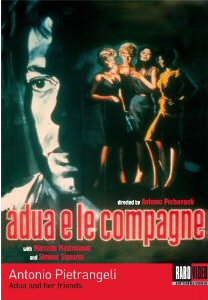
(A.k.a. ADUA E LE COMPAGNE; HUNGRY FOR LOVE)
It’s a bad time for Madame Adua (Simone Signoret) and her girls: as the film opens, their brothel – based on the busy streets of Rome – is enjoying its last night of business. The women are doing their best to satisfy their clients, but there is tension in the air. No-one likes being told they no longer have a job.
For Adua and co, their fate is sadly set in stone: a new ruling has outlawed bordellos in the capital. "Just think about those boys who’ll be 18 tomorrow", purrs Adua sarcastically, "real bad luck".
Behind the scenes, packing up their belongings in their shared boudoirs, the girls are all apprehensive about what the future holds for them. Even Adua. Some claim to have rich boyfriends (clients?) who are going to open up shops for them ... but all seem lost, ultimately.
It seems inevitable, then, that a small group of them should pool their resources together and set off in their car in search of a new life together. Adua calls the shots amid lots of bickering between the feisty Lolita (Sandra Milo), Marilina (Emmanuelle Riva) and Caterina (Gina Rovere).
Between them, they settle on a small town and decide to rent a large run-down building there where they can run a restaurant. Restoring the decrepit place becomes a labour of, well, labour ... but Adua keeps her increasingly disgruntled friends focused on the end result. However, a problem arises: the girls are unable to obtain a license.
Enter an unscrupulous local businessman who offers to obtain the license for the girls. His one proviso: he wants them to turn tricks above the restaurant.
By this time, the girls have effectively turned their lives around (well, save for one ...) and the prospect of sleeping with strangers on a nightly basis no longer appeals.
It’s a sticky predicament for all, and the drama unfurls from there – leading to a commendably feasible resolution that eschews the Hollywood route of sugar-coated endings, and opts for something approaching realism instead. It helps ADUA AND HER FRIENDS resonate all the more for it.
Directed with unerring pace and fluidity by Antonio Pietrangeli, the film also stars Marcello Mastroianni as Adua’s eventual love interest (a right bum he is too).
ADUA looks marvellous from the offset. The combination of perfectly lit exterior night scenes and monochrome daytime cinematography lend the film a wonderful, poetic grace not too dissimilar to that of classic French cinema such as LES YEUX SANS VISAGE or LES DIABOLIQUES.
Of course, the latter also famously starred Signoret. She stole the show there as a ruthless schemer, a real femme fatale. Here, she’s equally as impressive if not a tad more sympathetic. She dominates the screen once again. Mastroianni’s appeal is not usually questioned, I know ... but he didn’t really register here.
Pierro Picconi’s soundtrack is sexy, sassy and perfectly in keeping with the mood of the film throughout. It’s a great complement to the striking visuals and quietly compelling drama. It also adds, along with the keen photography and sheer class of the cast, a definite respectability to the otherwise sleazy world that’s being portrayed. But not in a bad way: Pietrangeli pitches the film just right.
With gritty realism and gorgeous aesthetic qualities offered in equal abundance, ADUA is a real treat for cineastes. For all others, it still provides ample drama – tame by today’s standards, naturally (it’s possibly the only European film about prozzies that doesn’t offer sex or nudity), but still contemporary in its mood and unapologetic outcome.
Raro’s release is region-free. It packages the disc in a nice keepcase with outer card packaging, both of which boast differing cover art. Inside the case, there’s a great 12-page booklet containing cast filmographies, biographies and critical analyses of the film. It’s laced with photographs throughout.
The film is presented in its original 1.66:1 aspect ratio and has been enhanced for 16x9 televisions. It looks superb for a film of its age (1960). Blacks hold up well, images are sharp but natural, contrast is striking ... I was very content with the image quality throughout.
Italian mono dialogue is clean and clear for the duration: no concerns here. Better still, the optional English subtitles are well-written and easy to read at all times.
The disc opens with a spunky animated main menu page set to the film’s agreeable theme tune. From there, a static scene-selection menu allows access to the main feature via 16 chapters.
Extras, aside from the aforementioned book (which is, in itself, a fantastic supplementary feature) include the following:
An introduction to the film by Maurizio Poro. He’s an Italian film historian (that is, he’s Italian and he knows a lot about Italian films ...). He talks for seven minutes about how the director came to make this film, and how it fitted in with his other works. Covering the cast and the eventual public reaction to the film, among other things, Poro offers a wealth of trivia in the short amount of time he’s allotted. Again, very literate optional English subtitles are provided.
‘Girandola 1910’ is a short film that was directed by Pietrangeli as a segment of the portmanteau AMORI DI MEZZO SECOLO. This runs for 10 minutes, once more in Italian with optional English subtitles, and tells a curious tale of vintage love while offering a transfer that doesn’t look too bad considering its 1954 lineage.
A stills gallery runs for 1 minute and 44 seconds, offering grabs from the film.
Finally, there are biography and filmography notes on Pietrangeli.
Raro offer a top notch DVD release of a classic unsung gem of Italian cinema. Signoret shines.
Recommended.
Review by Stuart Willis
| Released by RaroVideo |
| Region 1 - NTSC |
| Not Rated |
| Extras : |
| see main review |